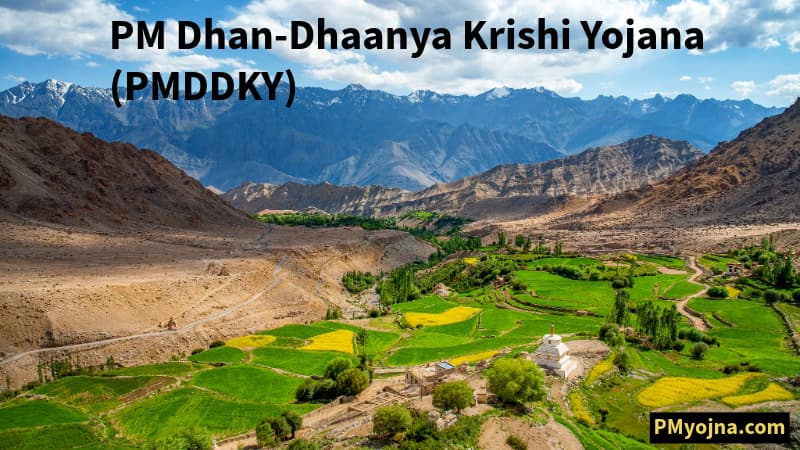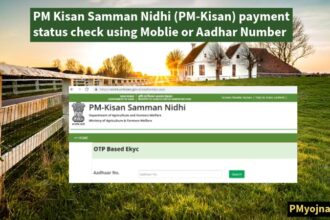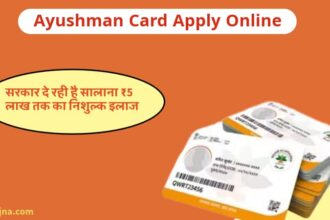PM Dhan-Dhaanya Krishi Yojana (PMDDKY) 2025- Check Districts List, Guidelines & Benefits
What is PM Dhan-Dhaanya Krishi Yojana?
- The Union Cabinet approved the scheme on 16 July 2025. (
- It will run for 6 years, from FY 2025-26 onward.
- The scheme focuses on 100 agricultural districts (often described as “low-performing” or “backward in agriculture”) across India.
- Its core idea is convergence: integrating and saturating 36 existing central schemes from 11 ministries (plus state/local schemes) in these target districts, so that farmers get a cohesive package of support.
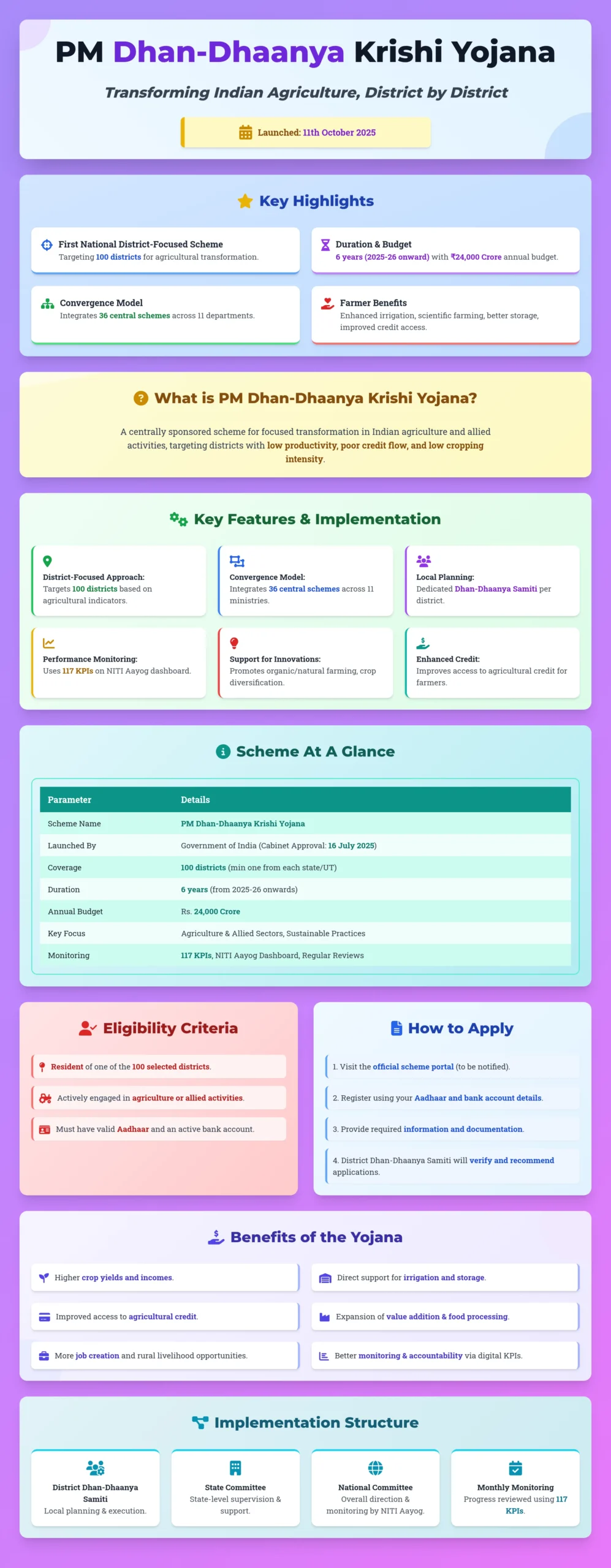
Objectives / Focus Areas
The scheme aims to address structural gaps in the selected districts by focusing on:
- Boosting Productivity
Improve yields through adoption of better inputs, improved agronomy, technology, etc. - Crop Diversification & Sustainable Practices
Encouraging farmers to move from mono-cropping to diversified, resilient cropping systems; promote organic/natural farming, water conservation, soil health, etc. - Post-Harvest Infrastructure
Creating storage, warehousing, cold storage, silos, packing units at block/panchayat level to reduce losses and improve value addition. - Irrigation Improvement
Expand irrigation coverage, adopt efficient micro-irrigation (drip, sprinkler), rejuvenate traditional water bodies etc. - Credit Access (Short-term & Long-term)
Facilitate farmers’ access to both crop loans and investment credit so that they can invest in inputs, equipment, innovation. - Local Planning & Monitoring
Each district will have a “District Dhan Dhaanya Samiti” (under the district collector) to prepare a District Agriculture & Allied Activities Plan, with inputs from progressive farmers, state agencies, agri universities, etc.
A digital dashboard will track progress monthly using ~117 Key Performance Indicators (KPIs).
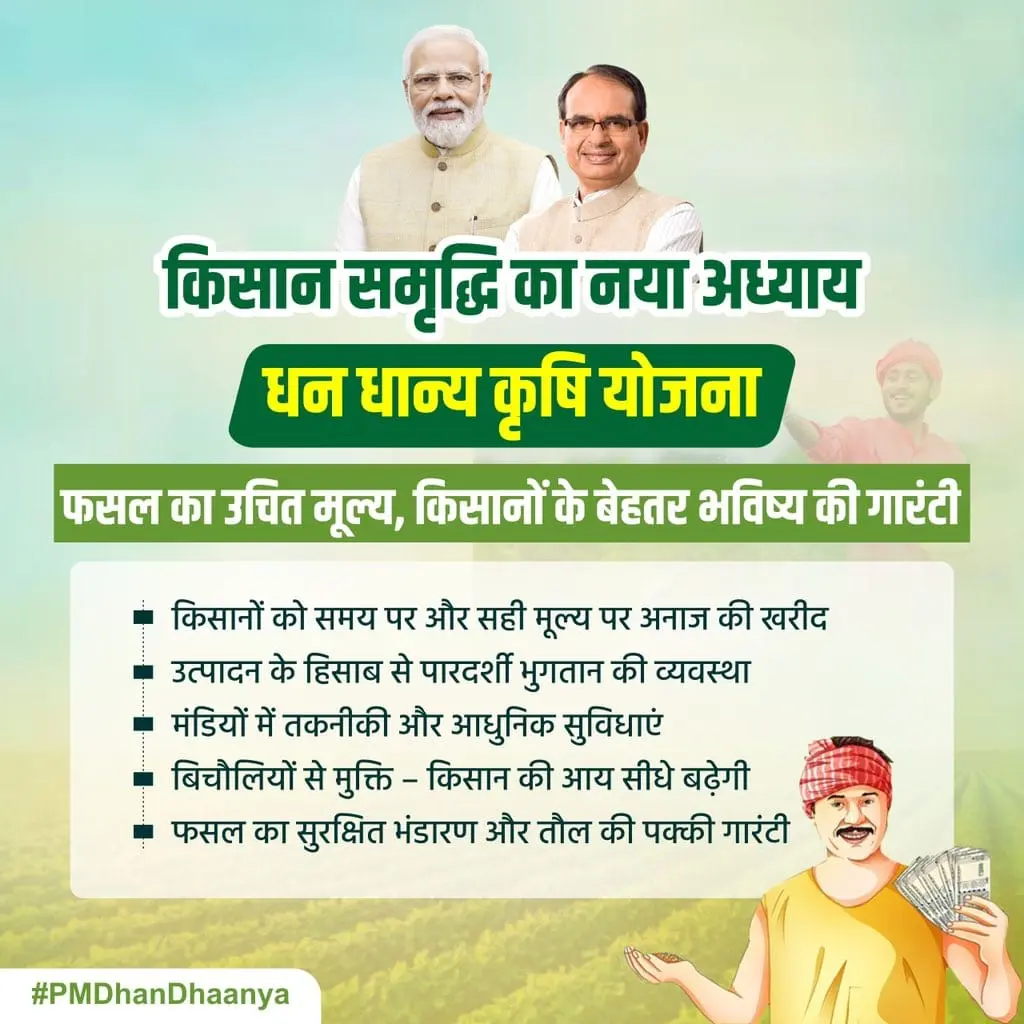
Scheme Cost, Scale & Beneficiaries
- Annual Outlay: ₹ 24,000 crore per year.
- Duration: 6 years (2025–26 to 2030–31, or similar)
- Beneficiaries: The scheme aims to benefit about 1.7 crore (17 million) farmers in these districts.
- District Selection Criteria:
- Low agricultural productivity
- Moderate/low cropping intensity
- Below-average access to agricultural credit/low credit disbursement
- The number of districts selected per state is proportionate to that state’s share of net cropped area / operational holdings, but each state/UT will have at least one district included.
Known / Reported Districts & States
While the official complete list of 100 districts is not yet public (or fully confirmed), a few districts and states have been mentioned in media reports as being included in PMDDKY:
- Rajasthan: Barmer, Jaisalmer, Nagaur, Jodhpur, Bikaner, Pali, Jalore, Churu
- Jharkhand: Simdega, West Singhbhum
- Karnataka: Haveri, Gadag
- Himachal Pradesh / Bilaspur district is also named among the 100 focus districts.
- Uttarakhand: Chamoli, Almora are mentioned in relation to the scheme / aspirational agricultural plans.
Because the selection is still being finalized/published, one must wait for the official notification (likely through the Ministry of Agriculture or state governments) to see the full list of 100 districts.
Eligibility Criteria
- Applicant must be a farmer or agri-entrepreneur residing in one of the 100 selected districts.
- Should be actively engaged in agriculture or allied activities.
- Must have valid Aadhaar and an active bank account.
How to Apply for PM Dhan-Dhaanya Krishi Yojana
- Visit the official scheme portal (to be notified soon; current updates may be found on pmkisan.gov.in or through district agriculture offices).
- Register using your Aadhaar and bank account details.
- Provide required information and documentation as per guidelines announced for your district.
- District Dhan-Dhaanya Samiti will verify and recommend applications for benefits under the scheme.
Benefits / Expected Impacts
From the available scheme documents and media reports, the benefits and expected impacts include:
- Increased agricultural yields and productivity in lagging districts
- Reduced post-harvest losses due to improved storage and processing infrastructure
- Better income for farmers through diversification and value addition
- Higher irrigation coverage and more efficient water usage
- Greater financial inclusion in agriculture via credit, especially for small and marginal farmers
- Promotion of environmentally sustainable and climate-resilient farming practices
- Empowerment of local decision making (district-level planning) and accountability via digital monitoring
- Convergence reducing duplication and improving synergies between multiple agriculture & allied schemes
List of Districts Covered under PM Dhan-Dhaanya Krishi Yojana
100 districts have been identified based on three parameters: low productivity, low cropping intensity, and less credit disbursement. At least one district from each state/UT is included. The detailed state-wise list of selected districts has been released by the Ministry of Agriculture & Farmers Welfare and is below.
| State | District |
| Andhra Pradesh | Sri Sathya Sai |
| Andhra Pradesh | Anantapur (Ananthapuramu) |
| Andhra Pradesh | Alluri Sitharama Raju |
| Andhra Pradesh | Annamayya |
| Arunachal Pradesh | Anjaw |
| Assam | Sribhumi (Karimganj) |
| Assam | Charaideo |
| Assam | Dima Hasao |
| Bihar | Madhubani |
| Bihar | Darbhanga |
| Bihar | Banka |
| Bihar | Gaya |
| Bihar | Siwan |
| Bihar | Kishanganj |
| Bihar | Nawada |
| Chhattisgarh | Dantewada |
| Chhattisgarh | Jashpur |
| Chhattisgarh | Korba |
| Goa | South Goa |
| Gujarat | Kachchh |
| Gujarat | Dohad/Dahod |
| Gujarat | Chhotaudepur |
| Gujarat | Panch Mahals |
| Haryana | Nuh |
| Himachal Pradesh | Bilaspur |
| Jammu & Kashmir | Kishtwar |
| Jammu & Kashmir | Baramulla |
| Jharkhand | Simdega |
| Jharkhand | West Singhbhum |
| Karnataka | Tumakuru |
| Karnataka | Chitradurga |
| Karnataka | Koppal |
| Karnataka | Gadag |
| Karnataka | Haveri |
| Karnataka | Chikkaballapura |
| Kerala | Kozhikode |
| Kerala | Kasaragod |
| Kerala | Kannur |
| Madhya Pradesh | Anuppur |
| Madhya Pradesh | Dindori |
| Madhya Pradesh | Alirajpur |
| Madhya Pradesh | Shahdol |
| Madhya Pradesh | Umaria |
| Madhya Pradesh | Sidhi |
| Madhya Pradesh | Niwari |
| Madhya Pradesh | Tikamgarh |
| Maharashtra | Palghar |
| Maharashtra | Yavatmal |
| Maharashtra | Gadchiroli |
| Maharashtra | Dhule |
| Maharashtra | Raigad |
| Maharashtra | Chandrapur |
| Maharashtra | Chhatrapati Sambhajinagar (Aurangabad) |
| Maharashtra | Nanded |
| Maharashtra | Beed |
| Manipur | Tamenglong |
| Meghalaya | West Jaintia Hills |
| Mizoram | Mamit |
| Nagaland | Mon |
| Odisha | Kandhamal |
| Odisha | Malkangiri |
| Odisha | Sundargarh |
| Odisha | Nuapada |
| Punjab | Fazilka |
| Rajasthan | Barmer |
| Rajasthan | Jaisalmer |
| Rajasthan | Pali |
| Rajasthan | Nagaur |
| Rajasthan | Jodhpur |
| Rajasthan | Bikaner |
| Rajasthan | Churu |
| Rajasthan | Jalore |
| Sikkim | Geyzing (formerly West District) |
| Tamil Nadu | Ramanathapuram |
| Tamil Nadu | Thoothukudi (Tuticorin) |
| Tamil Nadu | Sivaganga |
| Tamil Nadu | Virudhunagar |
| Telangana | Narayanpet |
| Telangana | Jogulamba Gadwal |
| Telangana | Jangoan |
| Telangana | Nagarkurnool |
| Tripura | North Tripura |
| Uttar Pradesh | Mahoba |
| Uttar Pradesh | Sonbhadra |
| Uttar Pradesh | Hamirpur |
| Uttar Pradesh | Banda |
| Uttar Pradesh | Jalaun |
| Uttar Pradesh | Jhansi |
| Uttar Pradesh | Unnao |
| Uttar Pradesh | Prayagraj |
| Uttar Pradesh | Chitrakoot |
| Uttar Pradesh | Pratapgarh |
| Uttar Pradesh | Shravasti |
| Uttar Pradesh | Lalitpur |
| Uttarakhand | Almora |
| Uttarakhand | Chamoli |
| West Bengal | Purulia |
| West Bengal | Darjeeling |
| West Bengal | Alipurduar |
| West Bengal | Jhargram |
PMDDKY Guidelines
The central government has also issued the detailed guidelines of PMDDKY at the official website which can also be downloaded from below link.
PM Dhan Dhaanya Krishi Yojana Guidelines PDF
FAQs
What is the main aim of PM Dhan-Dhaanya Krishi Yojana?
The scheme aims to transform agriculture and allied sectors in 100 low-performing districts through targeted investment, convergence of resources, and scientific practices for sustainable and profitable farming.
Who will benefit from this scheme?
Farmers, agri-entrepreneurs, and rural communities in the selected 100 districts, including at least one from each state and UT.
How will progress be monitored?
Monthly progress will be tracked using 117 Key Performance Indicators (KPIs) via a digital dashboard. Regular reviews will be conducted by central, state, and district committees, as well as NITI Aayog.
Will the private sector be involved?
Yes, local private sector participation is encouraged for innovation, technology adoption, and value addition at the district level.
When will the scheme start?
The scheme has launched on 11th October and implementation has also started in financial year 2025-26 and continue for six years.

